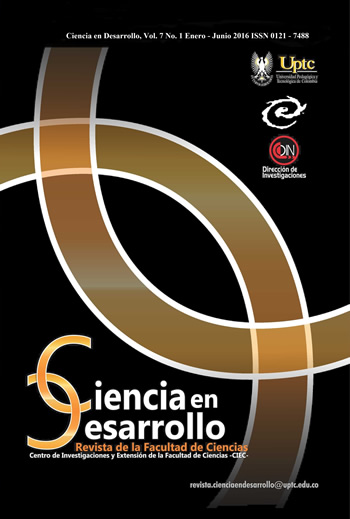Application of the Copula-Graphic Estimator in Juvenile Bocachico Prochilodus Magdalenae Subjected to Different Levels of Salinity.

Abstract
In this paper, it is estimated the role of survival under dependence using the copula-graphic estimator
proposed by [2]. A simulation study is carried out for Weibull failure times, with two failure modes and
different percentages of censorship, where the survival function is compared through the copula-graphic
estimator, with the survival estimation assuming independence from two failure modes. It is shown a study application carried out in the Fishing Research Center of the University of Cordoba-CINPIC (Colombia), in which the mortality of juvenile fish subjected to different levels of salinity is wanted to be analyzed, and what constitutes the failure modes or causes of death (10 ppm and 12 ppm). It was found that assuming independence in the failure modes the survival function, underestimates the true survival rate, which is estimated in a reliable manner with the estimator copula graphic, in which the dependency between the failure modes is taken into account.
Keywords
Estimador cópula gráfico, censura, función de superviencia. (Censored, Estimator Copula-Graphic, Survival Function.)
References
- B. Baldisserotto, Fisiología Aplicada a Peixes Piscicultura, Ed. UFSM, Santa Maria , 2002.
- M. Zheng, M. and J. Klein, “Estimates of marginal survival for dependent competing risks based on an assumed copula”, Biometrika, vol. 82, no. 1, pp. 12-38, 1995. DOI: https://doi.org/10.1093/biomet/82.1.127
- A. Tsiatis, A nonidentifiability aspect of the problem of competing risks, 2da Edn, Ed Proc. Natl. Acad. Sci., USA, 1975. DOI: https://doi.org/10.1073/pnas.72.1.20
- W. Meeker, L. Escobar, and Y. Hong, “Using Accelerated Life Tests Results to Predict Product Field Reliability”, Technometrics, vol. 52,
- no. 1, pp. 146-161, 2009. DOI: https://doi.org/10.1016/j.cej.2008.05.028
- R. E. Barlow, and F. Proschan, Statistical Theory of Reliability and Life Testing, Ed Holt, Richard Winston. Sci., New York, 1975.
- G. Escarela, y J. Carriere, “Fitting Competing risks with an assumed copula”, Statistical Methods in Medical Research, vol. 12, no. 4, pp. 333-349, 2003. DOI: https://doi.org/10.1191/0962280203sm335ra
- B. Schweizer, and A. Sklar, Probabilistic Metric Spaces, 2da Edn, Ed Dover Publications, New York, 1983.
- J. I. Mojica, C. Castellanos, S. Usma. y R. Álvarez, Libro Rojo de peces dulceacuícolas de Colombia, Ed Universidad Nacional de Colombia, Bogotá, 2002.
- A. Calderer, Influencia de la temperatura y la salinidad sobre el crecimiento y consumo de oxígeno de la dorada (Sparus aurata L.), Ed
- Universidad Nacional de Colombia, Tesis de doctor en Ciencies Biologiques, Bogotá, 2001.
- W. Holmes, y E. Donaldson, “Fisiología de los peces: Los compartimentos del cuerpo y la distribución de los electrolitos”, Academic Press, vol. 1, pp. 1-89, 1969.
- F. Beux, Da Efeito salinidade na Sobrevivencia de larvas de surubí ( Pseudoplatystoma corruscans) (Agassiz, 1829) (Pisces: Pimelodidae), Technical report, XIII Congresso Brasileiro de Engenharia de Pesca-CONBEP, XIII, Porto Seguro - BA., 2003.
- V. Stappen, Manual para la producción y uso de alimentos vivos para la acuicultura, Technical report, FAO Documento Técnico de Pesca. no. 361. Roma, XIII, pp. 107-123, 1996.
- L. Beux, and E. Zaniboni-Filho, Influencia da baixa salinidade na Sobrevivencia de nauplios de Artemia sp, Technical report, Boletim do
- Instituto de Pesca, São Paulo, XIII, pp. 73-77, 2006.
- J. Lu, and G. K. Bhattacharryya, “Some New Constructions of Bivariate Weibull Models”, Annals of the Institute of Statistical Mathemati, vol. 43, no. 3, pp. 543-559, 1990. DOI: https://doi.org/10.1007/BF00049307
- E. W. Frees, J. F. Carriere, and E. Valdez, “Annuity valuation with dependent mortality”, Journal of Risk and Insurance, vol. 63, pp. 231- DOI: https://doi.org/10.2307/253744
- , 1996.
- S. Yañez, H. Brango, M. Jaramillo, y C. Lopera., “Comparación entre riesgos competitivos vía estimador cópula-gráfico”, Revista Colombiana de Estadística, vol. 34, no. 2, pp. 231-
- , 2011.